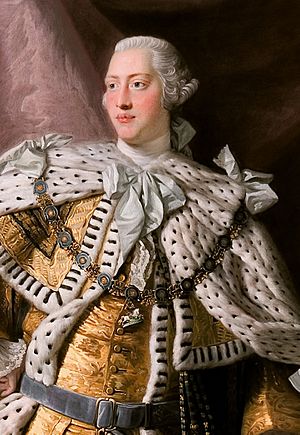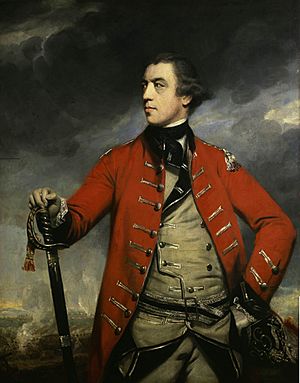Siege of Fort Ticonderoga (1777) facts for kids
Quick facts for kids Siege of Fort Ticonderoga (1777) |
|||||||
|---|---|---|---|---|---|---|---|
| Part of the American Revolutionary War | |||||||
Fort Ticonderoga as seen from Mount Defiance |
|||||||
|
|||||||
| Belligerents | |||||||
Iroquois |
|||||||
| Commanders and leaders | |||||||
| Strength | |||||||
| 7,800 | 3,000 | ||||||
| Casualties and losses | |||||||
| 5 killed | 18 killed and wounded | ||||||
The 1777 Siege of Fort Ticonderoga was an important event during the American Revolutionary War. It happened between July 2nd and 6th, 1777, at Fort Ticonderoga in New York. A large British army, led by Lieutenant General John Burgoyne, surrounded the fort. The American soldiers, commanded by General Arthur St. Clair, were outnumbered. They decided to leave the fort to save their army.
There was some shooting and a few people were hurt. But there wasn't a big battle or a long siege. Burgoyne's army took over Fort Ticonderoga and Mount Independence without a fight on July 6th. This quick surrender surprised many Americans. Fort Ticonderoga was thought to be very strong and important for defense. Generals St. Clair and Philip Schuyler were criticized for losing it. Later, both were found innocent by a military court, but their careers were affected.
Contents
Background to the Conflict
The American Revolutionary War began in 1775. In 1775, American forces tried to invade Quebec, but it didn't go well. By July 1776, the American army was pushed back to Fort Ticonderoga. A small American navy fleet on Lake Champlain was defeated in October 1776. This battle, called the Battle of Valcour Island, delayed the British attack on Ticonderoga in 1776. Even though British troops got close, their commander, General Guy Carleton, decided to pull back to Quebec because winter was coming.
British Army Plans
In May 1777, General John Burgoyne arrived in Quebec. He planned to lead British forces south. His goal was to control Ticonderoga and the Hudson River valley. This would split the American colonies in two.
Burgoyne's army had about 7,000 regular soldiers. They also had about 800 Native American allies. A small number of Canadiens and Loyalists also joined them. These groups mostly worked as scouts. The army also had over 1,000 civilians, including families. In total, Burgoyne's group was more than 10,000 people.
On June 14, Burgoyne's troops gathered at Fort Saint-Jean. By June 21, they were on Lake Champlain. They reached Fort Crown Point by June 30. The Native American scouts were so good that the Americans at Ticonderoga didn't know how big or where the British force was.
American Defenses at Ticonderoga
American forces had held Fort Ticonderoga since they captured it in May 1775. In 1776 and 1777, they worked hard to make the defenses stronger. They built many forts and walls. A nearby area, Mount Independence, was also heavily fortified. They even built a floating bridge across the lake. This bridge helped soldiers move between Ticonderoga and Mount Independence.
The command at Ticonderoga changed often in 1777. General Philip Schuyler was in charge of the Northern Department. General Horatio Gates was in charge of Ticonderoga. Then, Congress gave Gates command of the whole department. Schuyler protested, and Congress changed it back. Gates then left, and General Arthur St. Clair took command of the fort. He arrived only three weeks before Burgoyne's army.
The American forces were not at full strength. They had soldiers from the Continental Army and militia from New York and other states. On June 20, Generals St. Clair and Schuyler held a meeting. They decided that their 2,500 soldiers were not enough to defend the fort. They planned two ways to retreat. One way was by boat up the lake to Skenesboro. The other was by a rough road east toward Hubbardton.
The Sugar Loaf Problem
A hill called Sugar Loaf (now Mount Defiance) overlooked both Ticonderoga and Mount Independence. If the British put cannons on this hill, the fort would be impossible to defend. John Trumbull had pointed this out earlier. People thought it was impossible for the British to drag cannons up the steep hill. However, Trumbull, Anthony Wayne, and Benedict Arnold had climbed it. They realized cannons could probably be pulled up.
Defending Sugar Loaf was difficult. Many believed Fort Ticonderoga, known as the "Gibraltar of the North," had to be held. Abandoning it was not an option. Defending the fort and its outer walls would use all the American troops. This left no soldiers to defend Sugar Loaf. Also, George Washington and Congress thought Burgoyne would attack from the south, not from Quebec.
After the meeting on June 20, Schuyler told St. Clair to hold the fort as long as possible. He also told him to make sure his escape routes were not cut off. Schuyler gathered 700 reserve troops in Albany. Washington also prepared four regiments in Peekskill.
The Battle Unfolds
British Movements
On July 1, General St. Clair still didn't know how strong Burgoyne's army was. Burgoyne's forces were only about 4 miles (6.4 km) away. Burgoyne sent his advance troops to the west side of the lake. Their goal was to cut off the defenses at Mount Hope. German soldiers were sent to the east side of the lake. Their target was Mount Independence and the road to Hubbardton. Burgoyne ordered his army to move forward on July 2.
On the morning of July 2, St. Clair decided to pull back his men from Mount Hope. This position was exposed and could be easily captured. The American soldiers set fire to their works and retreated. They got away just before Burgoyne's advance guard arrived. That afternoon, some British soldiers and Native Americans fired at the American lines. St. Clair told his men to wait until the enemy was closer. But James Wilkinson fired, and other American soldiers followed. The British soldier Wilkinson shot fell, and the British troops ran away. When the soldier was captured, he was found to be unhurt. St. Clair learned about the British forces by tricking this captured soldier.
On July 3, British advance forces took Mount Hope. Burgoyne sent some scouts and Native Americans to the east side of the lake. He also moved some German soldiers to the west side. Some British camps were close enough to the American lines to be bothered by gunfire. But this didn't stop the British from fixing bridges on the road between Ticonderoga and Lake George.
British engineers found the important position of Sugar Loaf. They realized they could use it after the Americans left Mount Hope. Starting on July 2, they began clearing the top of the hill. They built places for cannons, working carefully so the Americans wouldn't notice. They spent several days pulling their large cannons up the slope. Burgoyne wanted to surprise the Americans only when the German troops were ready to block their retreat.
American Retreat from the Fort
On July 4, the Americans quietly celebrated the Declaration of Independence. That night, the British lost their surprise. Some Native Americans lit fires on Sugar Loaf, showing their presence to the Americans. On the morning of July 5, St. Clair held a meeting with his officers. They decided to retreat. Since their position was fully exposed, they waited until nightfall to move. This way, their movements would be hidden. St. Clair knew he would be criticized. He said he could "save his character and lose the army" by holding the fort, or "save the army and lose his character" by retreating.
All possible weapons, sick soldiers, camp followers, and supplies were loaded onto over 200 boats. These boats moved up the lake toward Skenesboro. Colonel Pierse Long's regiment went with them. There weren't enough boats, so four sick soldiers were left behind. Also, the very largest cannons and many supplies were left. The rest of the army crossed to Mount Independence. They then headed down the Hubbardton road. Burgoyne's German forces had not yet reached this road. A few men stayed at the floating bridge with loaded cannons. They were to fire on any British attempts to cross.
The British arrived the next morning. They took over the forts without firing a single shot. Parts of Fraser's and Riedesel's troops chased the retreating Americans on the Hubbardton road. Burgoyne quickly sent some of his troops up the lake toward Skenesboro.
What Happened Next
At least seven Americans were killed and 11 wounded in small fights before the retreat. British casualties were not fully counted, but at least five were killed.
The Americans moved quickly on the Hubbardton road. Most of the army reached Castleton, about 30 miles (48 km) away, on the evening of July 6. The British chase led to the Battle of Hubbardton when they caught the American rear guard on July 7. But this allowed the main American army to escape. They eventually joined General Schuyler at Fort Edward. The smaller American force that went by boat to Skenesboro fought Burgoyne's advance troops in the Battle of Fort Anne. However, they had to leave behind equipment and many sick and wounded soldiers.
The events at Ticonderoga didn't slow Burgoyne much. But he had to leave over 900 men to guard the Ticonderoga area. He also had to wait until July 11 for his army to gather at Skenesboro. Then, he faced delays on the heavily wooded road to Fort Edward. General Schuyler's forces had made this road very difficult to use. They cut down trees across it and destroyed all its bridges. Burgoyne's campaign eventually failed. He was forced to surrender after the Battles of Saratoga. On November 20, General Gates reported that the British had abandoned and burned Ticonderoga and Independence.
Public Reaction and Political Impact

The public and political reaction to the American withdrawal was very strong. Congress was shocked and blamed both Schuyler and St. Clair for the loss. George Washington said it was "an event of chagrin and surprise." Rumors spread that St. Clair and Schuyler were traitors. People thought they had taken money to retreat.
Schuyler was eventually removed as commander of the Northern Department. General Gates replaced him. The fall of Ticonderoga was one of the reasons given. St. Clair was also removed from his command. He asked for a review by a military court. The court martial didn't happen until September 1778. St. Clair was found completely innocent. However, he never led troops in battle again. Schuyler was also cleared of any wrongdoing by a court martial.
News of the British victory made headlines in Europe. King George III of Britain was very happy. He reportedly burst into the Queen's rooms, shouting, "I have beat them! I have beat all the Americans!" The French and Spanish governments were less pleased. They had been supporting the Americans. This British victory made them demand that France and Spain close their ports to Americans. This demand was rejected, which increased tensions between the European powers.



